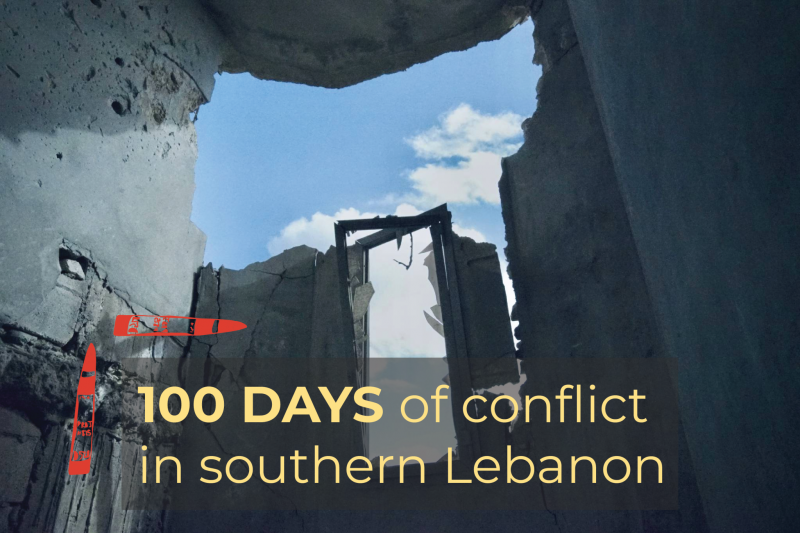
A wall that was struck by an Israeli shell in Aita al-Shaab, Nov. 27, 2023 (Credit: Olivia Le Poidevin)
For 100 days southern Lebanon has witnessed near-daily exchanges of strikes between the militant group Hezbollah and the Israeli army. Tens of thousands of families have fled their homes and a number of civilians have died. L'Orient Today assesses how this war, without a name, has impacted the country, its economy, its villages and its people.
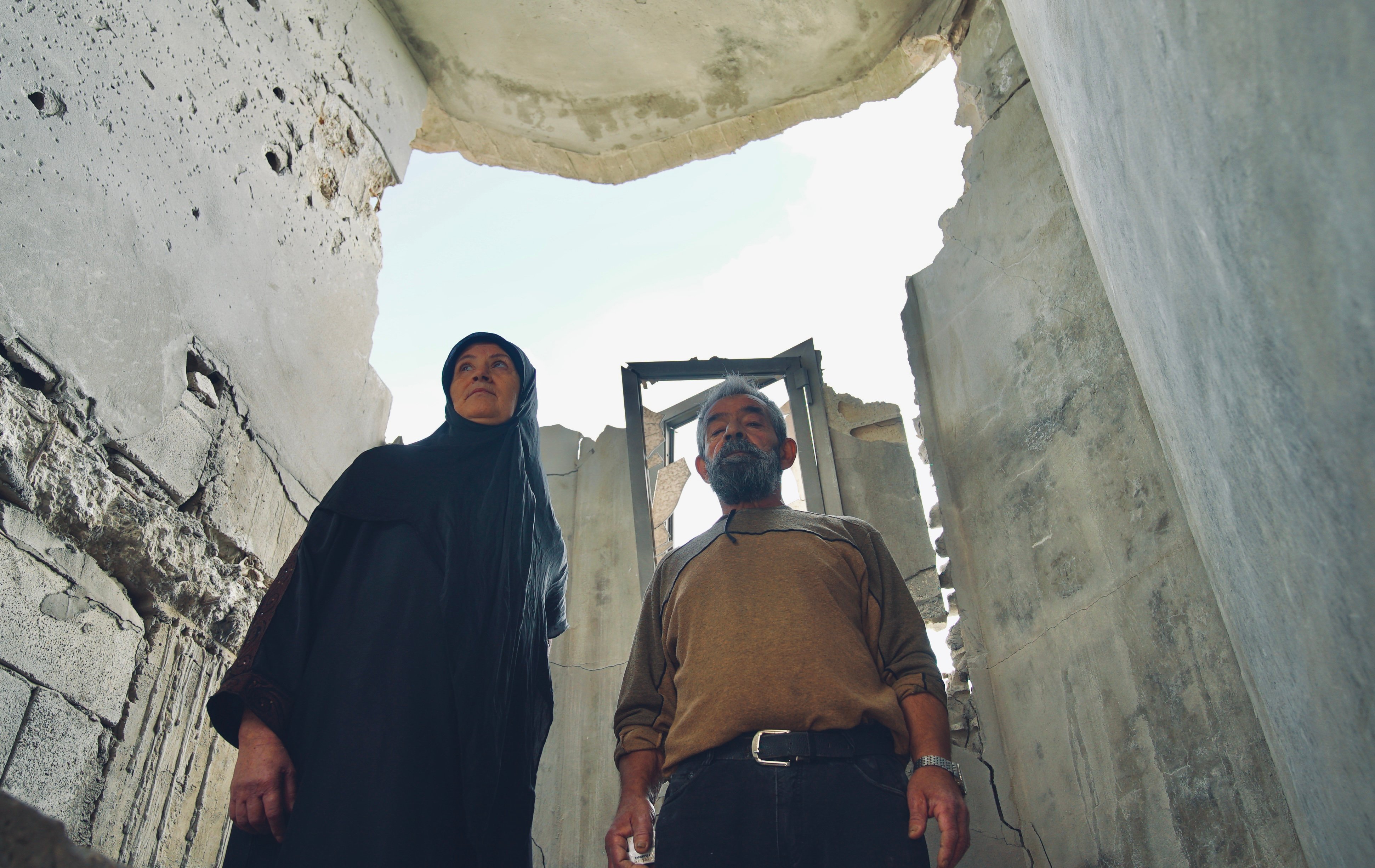 Wafika and Hassan Jawad stand amongst ruins in Aita el-Chaab. Nov. 27, 2023. (Credit: Olivia Le Poidevin/L'Orient Today)
Wafika and Hassan Jawad stand amongst ruins in Aita el-Chaab. Nov. 27, 2023. (Credit: Olivia Le Poidevin/L'Orient Today)
Who are the displaced in Lebanon?
82,012 people have been displaced since fighting began between Hezbollah and the Israeli army, Oct. 8, 2023 – according to the latest published by the UN's International Organization for Migration (IOM). Nearly one in five of those forced from their homes are children.
Data shows that within the span of a week (Nov. 7 to Nov. 14) the number of displaced doubled, from 26,323 to 46,325. There was also a substantial increase from early December to early January, with a further 18,083 people leaving their homes.
Scroll on the image for more information
Where are they fleeing from?
The majority of people displaced come from three districts along Lebanon's southern border with Israel: Bint Jbeil (47 percent), Marjayoun (34 percent) and Sour (12 percent). In the past week, 3,118 new displacements have been recorded in Bint Jbeil, Nabatieh, Marjayoun, Hasbaya, Baabda, and Sour districts. According to the IMO, they may be on the move for the first time, or second time.
Where are they fleeing to?
They have relocated across eight districts throughout the country. The governanate of Sour has received 24,317 people fleeing the fighting, a third of those displaced, followed by Nabatieh and Saida.
Around 81 percent of IDPs are currently living with host families. 16 percent are in rented accommodation. But as L'Orient Today has previously reported, a spike in rental prices has made this option unaffordable for many families.
Among some of those displaced are Syrians – who have already faced a long journey of continual displacement, fleeing from the war in Syria to Lebanon, to then have to move again.
Agricultural impact of the war
Since Oct. 8, the agricultural sector in southern Lebanon has faced devastation. Richly fertile, thanks to its ideal growing conditions, southern Lebanon grows 22 percent of the country’s fruit and citrus, 38 percent of its olives, according to the Ministry of Economy in Lebanon. The economic importance of the agricultural sector is considerable, making up to 80 percent of southern Lebanon's local GDP, according to a UNDP report published in December.
The start of military confrontations between Hezbollah and the Israeli army happened during the fruit and olive harvest season. Many agricultural workers like Joud in Aitaroun, had to flee their homes for safety as Israeli bombardments intensified.
The American University of Beirut’s Nature Conservation Center has found four previous cases of Israel using white phosphorous – however, the Tahrir Institute for Middle East policy notes that the recent conflict of Oct. 8, 2023, until now “marks the first time agricultural areas in Lebanon have been this openly and extensively targeted.”
It added that Israel "seems to be deliberately maiming green areas free of any military targets" in an attempt to "incur serious environmental and economic damage. “Israel has previously denied using white phosphorus in Lebanon.
The latest data from Lebanon's National Early Warning System platform shows that, until Jan. 1, 2024: approximately 8 million square meters (800 hectares) of land have experienced fires "resulting from Israeli attacks."
Scroll on the image for more information
Earlier, on Nov. 16, it was reported that 5,140,000 square meters of land were scorched by white phosphorus and flare bombs in southern Lebanon, according to ground surveys completed by the National Council for Scientific Research (CNRS). At least 50,000 olive trees have been lost, according to Agriculture Minister Abbas Hajj Hassan. The Tahrir Institute suggests that national olive production profits have been affected by potential losses to the olive harvest, which usually amounts to $23 million in exports – according to data from 2020.
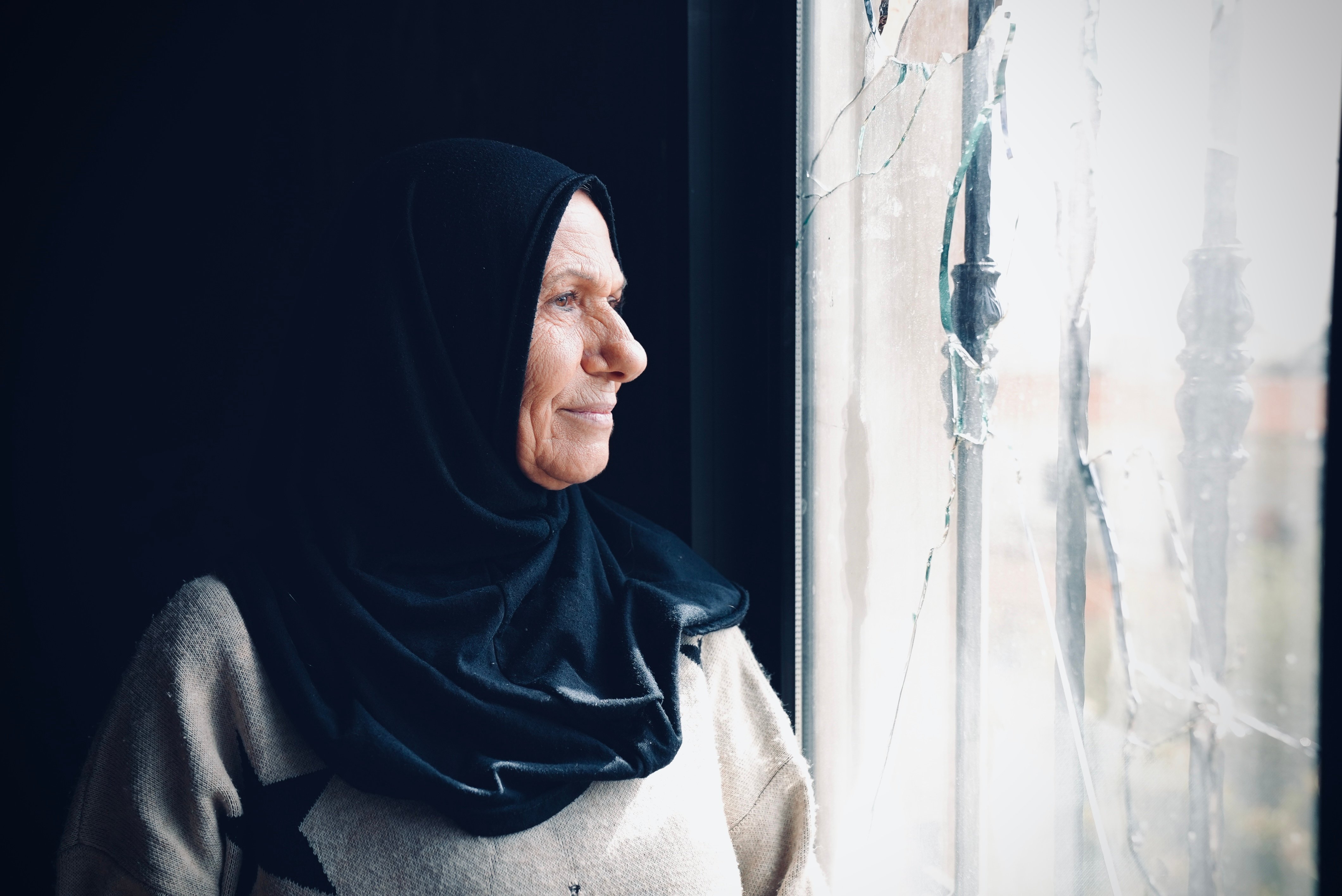 Rosa Srour looking through a window in her house in Aita al-Shaab, southern Lebanon, damaged by a Israeli air strike, Nov. 27, 2023 (Credit: Olivia Le Poidevin)
Rosa Srour looking through a window in her house in Aita al-Shaab, southern Lebanon, damaged by a Israeli air strike, Nov. 27, 2023 (Credit: Olivia Le Poidevin)
Damage to villages
91 villages have been subject to cross-border attacks from Israeli forces since the start of the war, and dozens of buildings completely destroyed, according to a report in December by UNDP. Infrastructure and economic and social services have been significantly disrupted.
Data by L'Orient Today has found that Aita al-Shaab, Yaroun and Mais al-Jabal have been the three most targeted villages in southern Lebanon.
"A third of houses in Aita al-Shaab have also suffered damage,” prompting "an exodus of hundreds of families to safer regions," according to a member of the municipal council of Aita al-Shaab, who spoke to L'Orient Today on the condition of anonymity.
“These areas in question are situated less than three kilometers from the border, and therefore within the five-kilometer perimeter defined by the rules of engagements,” explained Gen. Amine Hoteit, a former army officer and military strategist who is close to Hezbollah. “They are situated in front [of] Israeli military posts,” he added, highlighting that "they are part of a delimited zone, defined by geopolitics, including 14 villages between Naqoura and Mtolleh.
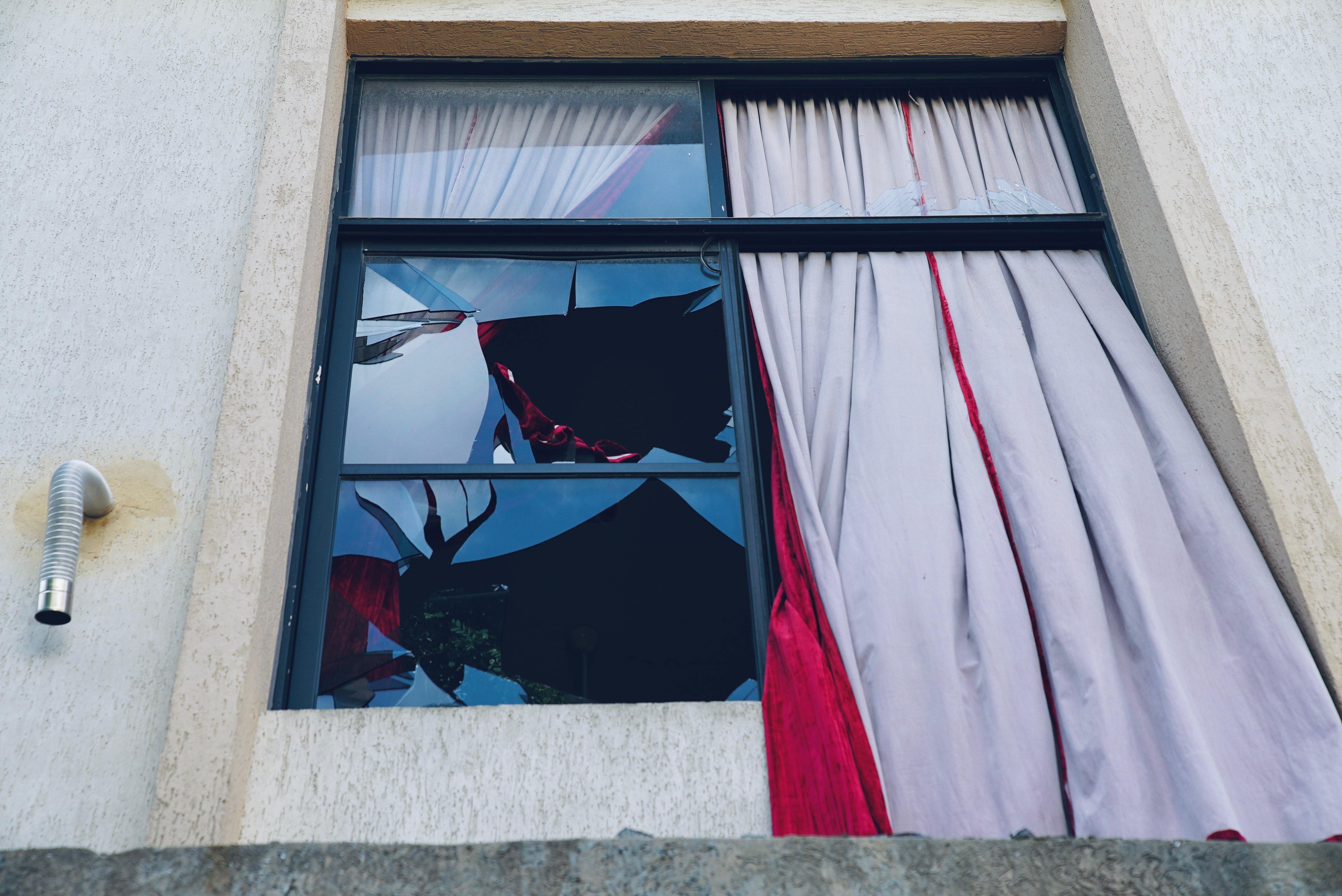 A broken window in Aita al-Shaab, southern Lebanon, damaged by a Israeli air strike, Nov. 27, 2023 (Credit: Olivia Le Poidevin)
A broken window in Aita al-Shaab, southern Lebanon, damaged by a Israeli air strike, Nov. 27, 2023 (Credit: Olivia Le Poidevin)
Economic impact of the war on Lebanon
In December, the United Nations Development Programme, World Bank and Lebanon Economic Monitor shared concerns about the impact of the war on Lebanon's already fragile economy, which is in the midst of a historic economic crisis that has seen its national currency plummet and inflation snowball.
Lebanon – alongside Jordan and Egypt – could see a two to four percent loss in its GDP as a result of the war – with Lebanon at particular economic risk, the United Nations Development Programme (UNDP) said in its report, published on 19 December. Such a drop in GDP in the three months since Oct. 7, when the war began, would constitute “a massive loss,” said UNDP regional director Abdallah al-Dardari.
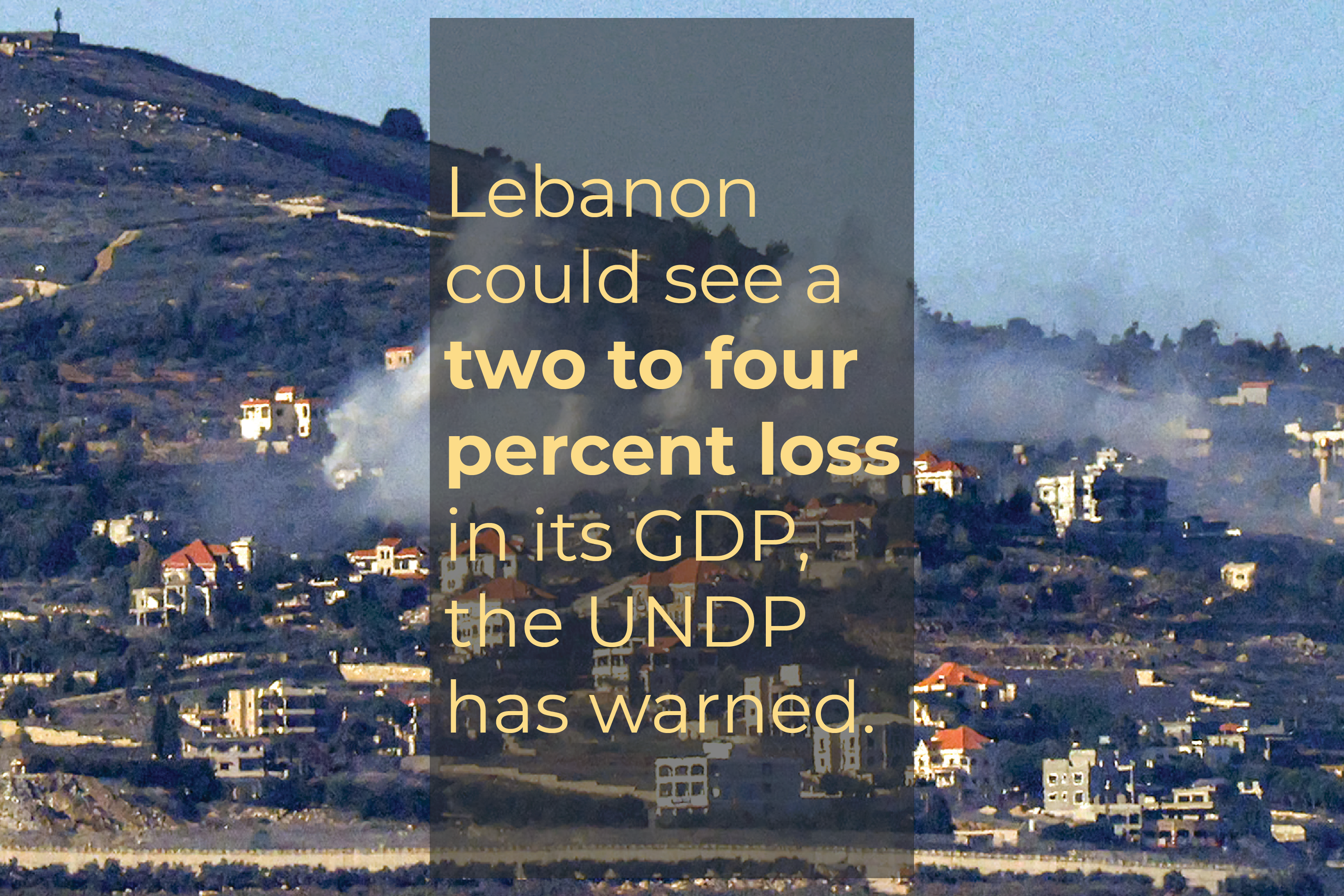 This picture taken from a position along the border in northern Israel on Dec. 25, 2023 shows smoke billowing in the southern Lebanese village of Odaisseh following Israeli bombardment amid ongoing cross-border tensions as fighting continues between Israel and Hamas militants in the Gaza Strip. (Credit: Jalaa Marey / AFP)
This picture taken from a position along the border in northern Israel on Dec. 25, 2023 shows smoke billowing in the southern Lebanese village of Odaisseh following Israeli bombardment amid ongoing cross-border tensions as fighting continues between Israel and Hamas militants in the Gaza Strip. (Credit: Jalaa Marey / AFP)
In its report, the World Bank recalls that the 2006 conflict in Lebanon – which saw the Israeli army temporarily invade the southern part of the country – resulted in "an economic production loss of 10.5 percent of GDP and direct and indirect damages of 3.1 billion dollars."
The escalation of the conflict could have a "severe and lasting impact on Lebanon's already weak infrastructure in the sectors of electricity, water, and transportation," says the Lebanon Economic Monitor (LEM).
Key moments during the conflict in southern Lebanon:
- Oct. 7: Hamas launches its assault on Israel "Operation Al-Aqsa Flood"
- Oct. 8: Hezbollah and the Israeli army begin exchanging cross-border fire between southern Lebanon and northern Israel.
- Oct. 13: Reuters visuals journalist, Issam Abdallah, 37, is killed and Agence France-Presse (AFP) photographer Christina Assi, 28, is severely wounded and five other reporters are injured, just over a kilometer from the Israeli border near the Lebanese village of Alma al-Shaab. An investigation by Reuters found Issam Abdallah was killed by Israeli tank fire.
- Oct. 19: A Civilian in the company of a journalist team is killed by "Israeli machine gun fire" in Houla, according to the Lebanese army.
- Nov. 3: Hassan Nasrallah's first speech since the start of Israel-Hamas war. He does not signal an imminent escalation, but says the party may resort to unspecified “options …at any time."
- Nov. 4: Lebanon's caretaker Prime Minister, Najib Mikati asks US Secretary of State Anthony Blinken and the international community to "pressure Israel to stop its daily violations of [Lebanese] land."
- Nov. 5: An Israeli drone strike targets a civilian car in Ghodmata, on the road between Aitaroun and Ain Ebel, killing Remas Mahmoud Chour, 14, her sisters Taleen, 12, and Layan, 10, and their grandmother Samira Abdel Hussein Ayoub. Their mother, Hoda Hijazi, was injured and taken to hospital. Referring to the Israeli strike, caretaker Prime Minister Najib Mikati condemned the “heinous crime.” On Nov. 6, Lebanon filed a complaint with the UN Security Council regarding the “killing of children and civilians” by Israel in southern Lebanon.
- Nov. 21: Journalists Farah Omar, 25, and reporter Rabih Maamari, 39, from the pro-Iranian and pro-Hezbollah Lebanese TV channel, al-Mayadeen, and their civilian companion, Hussein Akil, were killed in an Israeli bombardment in the border area of Tayr Harfa. On the same day 80-year-old Laiqa Sarhan was killed and her seven-year-old granddaughter was injured in an Israeli strike in Kfar Kila.
- Nov. 22: Five people are killed in Beit Yahoun (Bint Jbeil), including Abbas Mohammad Raad, the son of Hezbollah MP Mohammad Raad who leads the party's bloc in Parliament.
- Dec. 1: A mother and her son, a Hezbollah member, are killed when an Israeli strike hits their house in Houla. Another person is killed and three injured in another Israeli air strike on a house in Jibbain.
- Dec. 10: Israeli bombardments cause massive damage in the village of Aitaroun (Bint Jbeil). The main road linking the villages of Qantara and Taybeh (Marjayoun) is also damaged.
- Dec. 20: Shelling on Markaba kills a 70-year-old man and injures others. Additionally, Israeli sniper fire killed a civilian whose car stalled on a road near Wazzani, Khiam and Kfar Kila in the Marjayoun district. The same day Israeli shelling hit a house in Blida, striking near the funeral procession of a Hezbollah member.
- Dec. 21: A woman is killed and two others injured in an Israeli bombardment that targets her home in Maroun al-Ras.
- Jan. 2: Hamas deputy leader Saleh Al-Arouri was assassinated in the southern suburbs of Beirut, along with other Hamas and Jamaa Islamiya leaders and members. Hezbollah has accused Israel of being behind the attack.
- Jan. 5: In a speech Hassan Nasrallah warns Lebanon could be 'exposed' to more Israeli attacks.
- Jan. 6: Hezbollah says it hit Israel's Meron air surveillance base with 62 missiles as part of the initial response to the assassination of Hamas senior leader Saleh al-Arouri and other Hamas and Jamaa Islamiya members.
- Jan. 8: Hezbollah commander, Wissam Tawil, was killed in an Israeli strike that targeted his vehicle in Khirbet Silm in southern Lebanon.
- Jan. 11: Hezbollah accuses Israel of hitting one of their medical centers in Hanine, killing two people and injuring others.